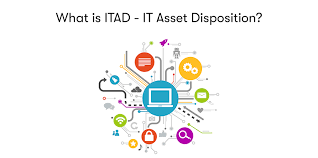
@Globaltech
2 Posts
2 Photos
0 Videos
Lives in New York
From New York
Female
31/12/1998
-
Maximizing Value and Sustainability through IT Asset Disposition (ITAD)
In today's fast-paced digital environment, businesses are constantly upgrading their IT infrastructure to keep pace with technological advancements. As organizations deploy newer, more efficient systems, the question arises: what happens to outdated or unused hardware? This is where IT Asset Disposition (ITAD) comes into play. ITAD is a critical business practice focused on the safe, secure, and environmentally responsible disposal or recycling of obsolete IT equipment. With data security, environmental sustainability, and regulatory compliance becoming top priorities for organizations, ITAD has emerged as an essential component of IT lifecycle management.
Source - https://www.marketresearchfuture.com/reports/it-asset-disposition-market-1002
IT Asset Disposition is more than just discarding old computers or servers; it is a structured approach that includes decommissioning, data sanitization, remarketing, recycling, and proper disposal. The primary goal of ITAD is to extract maximum value from retired IT assets while ensuring that sensitive data is completely erased and that equipment is handled in accordance with environmental and data protection regulations. Whether a company is refreshing hardware, relocating offices, downsizing, or undergoing a merger, a well-executed ITAD strategy mitigates risks and promotes operational efficiency.
One of the most critical aspects of ITAD is data security. Modern IT devices—servers, desktops, laptops, mobile phones, and storage drives—store vast amounts of sensitive information. Improper disposal of these assets could lead to data breaches, identity theft, and non-compliance with laws such as GDPR, HIPAA, or CCPA. To combat this, certified ITAD providers employ advanced data destruction methods, including physical shredding, degaussing, and software-based data wiping. These processes ensure that no recoverable data remains, giving organizations peace of mind and compliance assurance.
Another core element of ITAD is environmental responsibility. Discarded electronic devices, commonly referred to as e-waste, pose a significant threat to the environment due to the presence of toxic substances like lead, mercury, and cadmium. According to global statistics, millions of tons of e-waste are generated annually, but only a fraction is responsibly recycled. ITAD providers help minimize environmental impact by diverting waste from landfills through refurbishment, component recovery, and certified recycling processes. This not only reduces ecological harm but also supports corporate sustainability goals.
Maximizing Value and Sustainability through IT Asset Disposition (ITAD) In today's fast-paced digital environment, businesses are constantly upgrading their IT infrastructure to keep pace with technological advancements. As organizations deploy newer, more efficient systems, the question arises: what happens to outdated or unused hardware? This is where IT Asset Disposition (ITAD) comes into play. ITAD is a critical business practice focused on the safe, secure, and environmentally responsible disposal or recycling of obsolete IT equipment. With data security, environmental sustainability, and regulatory compliance becoming top priorities for organizations, ITAD has emerged as an essential component of IT lifecycle management. Source - https://www.marketresearchfuture.com/reports/it-asset-disposition-market-1002 IT Asset Disposition is more than just discarding old computers or servers; it is a structured approach that includes decommissioning, data sanitization, remarketing, recycling, and proper disposal. The primary goal of ITAD is to extract maximum value from retired IT assets while ensuring that sensitive data is completely erased and that equipment is handled in accordance with environmental and data protection regulations. Whether a company is refreshing hardware, relocating offices, downsizing, or undergoing a merger, a well-executed ITAD strategy mitigates risks and promotes operational efficiency. One of the most critical aspects of ITAD is data security. Modern IT devices—servers, desktops, laptops, mobile phones, and storage drives—store vast amounts of sensitive information. Improper disposal of these assets could lead to data breaches, identity theft, and non-compliance with laws such as GDPR, HIPAA, or CCPA. To combat this, certified ITAD providers employ advanced data destruction methods, including physical shredding, degaussing, and software-based data wiping. These processes ensure that no recoverable data remains, giving organizations peace of mind and compliance assurance. Another core element of ITAD is environmental responsibility. Discarded electronic devices, commonly referred to as e-waste, pose a significant threat to the environment due to the presence of toxic substances like lead, mercury, and cadmium. According to global statistics, millions of tons of e-waste are generated annually, but only a fraction is responsibly recycled. ITAD providers help minimize environmental impact by diverting waste from landfills through refurbishment, component recovery, and certified recycling processes. This not only reduces ecological harm but also supports corporate sustainability goals.0 Comments ·0 Shares ·334 Views ·0 Reviews
More Stories





